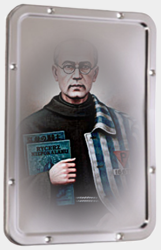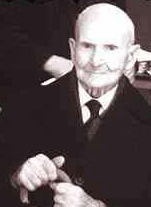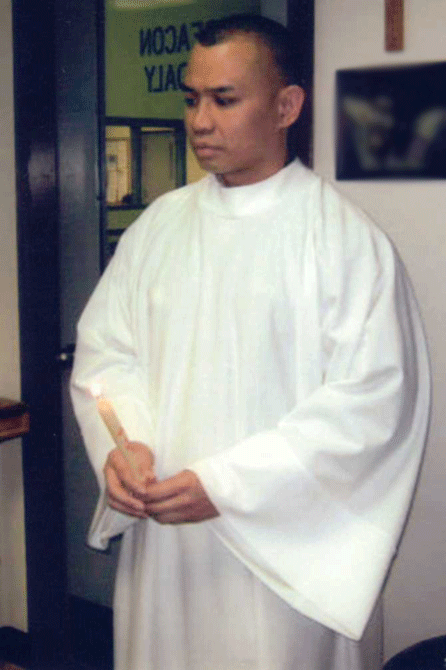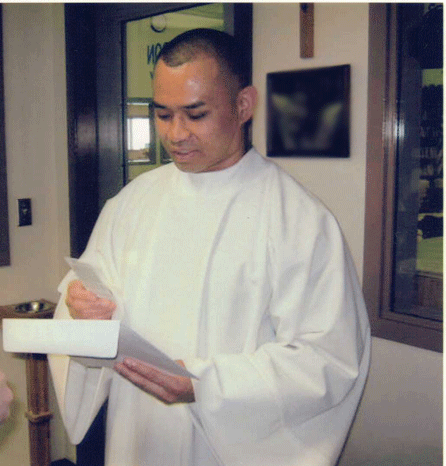In Honor of Saint Maximilian Kolbe, Patron of Prisoners, Priests, Bloggers
 Saint Maximilian Kolbe was a priest, prisoner, and gifted writer. He's the inspiration for These Stone Walls, and a model for living our faith in times of trial."But why did you start at the toilet?" Pornchai Moontri looked at me incredulously on the morning of his Baptism as he read my first post on These Stone Walls, "St. Maximilian Kolbe and the Man in the Mirror." I think he missed the point Here's how TSW's first post began:
Saint Maximilian Kolbe was a priest, prisoner, and gifted writer. He's the inspiration for These Stone Walls, and a model for living our faith in times of trial."But why did you start at the toilet?" Pornchai Moontri looked at me incredulously on the morning of his Baptism as he read my first post on These Stone Walls, "St. Maximilian Kolbe and the Man in the Mirror." I think he missed the point Here's how TSW's first post began:
"For someone on the outside looking in, it must seem an odd place to begin. Virtually every prison cell has one: a small stainless steel sink with a matching toilet welded to its side. Bolted to the cinder block wall just above it is a small stainless steel mirror, dinged, dented and scraped so badly that the image it reflects is unrecognizable.I begin each day at the break of dawn in prison by shaving in front of that mirror. This morning ritual has repeated 5,412 times. I seldom cut myself shaving - a minor miracle as I can see very little of me in that mirror. I often think of St. Paul’s cryptic image in his first letter to the Church at Corinth (13:12): 'For now, I see dimly, as in a mirror, but then I shall see face to face.' It is a hopeful image."
Well, okay! It WAS an odd place to start These Stone Walls, but the point was not the toilet! It was the mirror! Actually, the point was how the image of Saint Maximilian Kolbe came to reside in this cell above that battered mirror. It's the very same image you see on the TSW home page. I asked Suzanne to introduce this post with a larger copy of it.Look at the image closely for a moment. St. Maximilian is wearing both his Conventual Franciscan habit and the prison uniform issued to him at Auschwitz where his life on Earth ended. On his prison uniform is the identity given to him in prison: number 16670. In his right hand are two books, one with a Polish title and the other in Japanese. I don't know any prisoners here who read Polish, but my friend, Koji Goto, in Cell 10, reads Japanese. I asked him to look at the Japanese characters and translate them. Koji said they are pronounced "SEIBO NO KISHI." In English, "The Knights belong to their Mother."The Japanese title refers to the Militia of the Immaculata movement (MI) founded by Father Kolbe when he was still a seminarian. Today, the movement has millions of members worldwide. Suzanne Sadler is a member of the MI's, and so am I. Several TSW readers are also MI's. The movement binds its members together in a union with Christ through the Immaculate Heart of Mary through an Act of Consecration. The Miraculous Medal became the insignia of the MI movement asking Mary to act through its members as instruments of evangelization.THE COST OF MAXIMILIAN'S DISCIPLESHIPNinety-two years ago today - on April 28, 1918 - Father Maximilian Kolbe was ordained a priest at the Collegio Serafico in Rome. On the next day, April 29, the man whose priesthood would require his life celebrated his First Mass at the "Altar of Miracles" in Rome's Basilica of Saint Andrea delle Fratte. The young Maximilian had read that at this very altar, the Blessed Mother appeared to Alphonse Ratisbonne, an event that caused his instant conversion to the Catholic faith.It was reading of this conversion that gave Maximilian the idea of evangelization through Mary's intercession. By his fifth anniversary of Ordination, Pope Pius XI officially recognized Father Maximilian's Militia as a Primary Union of the Faithful. Father Maximilian then began publishing a popular magazine, first in Poland and then in Japan. As a publisher and writer, he was immensely successful.By the eve of World War II in 1939, the MI magazine had hundreds of thousands of readers in Poland and across Europe, and another 65,000 in Japan under the Japanese title, "Seibo No Kishi." This identified Father Maximilian as one of the most prolific Catholic writers of the 20th Century.It also cost him his life. When Nazi Germany invaded Poland in 1939, Maximilian was ordered to halt his publishing. He obeyed, for a time, but his conscience was stronger than his self-preservation. It wasn't long before the Gestapo showed up to arrest him. After several months in prison at Amtitz, he was released. He quickly began writing again.On February 17, 1941, Father Maximilian was arrested again and sent without trial to the Concentration Camp prison at Auschwitz. Hated by the Nazis for being a writer, for being a Pole, and for being a priest, Maximilian would never again emerge from that vast horror chamber."I WOULD LIKE TO TAKE THAT MAN’S PLACE"You know the truth of this story, but it bears repeating. In late July, 1941, a prisoner from Father Maximilian's cell block was erroneously thought to have escaped. Early in the morning, the prisoners were lined up. To encourage prisoners to inform on one another, the Nazi guards had a policy. If a prisoner escaped, ten others would be selected for execution. The last of the ten selected to die that day was a young man, Francis Gajowniczek, who cried in lament for the wife and children he would never see again. Father Maximilian quietly stepped forward. "What does this Polish pig want?" the Nazi commander shouted. Maximilian said,
The last of the ten selected to die that day was a young man, Francis Gajowniczek, who cried in lament for the wife and children he would never see again. Father Maximilian quietly stepped forward. "What does this Polish pig want?" the Nazi commander shouted. Maximilian said,
"I am a Catholic priest. I would like to take that man's place."
Two weeks later, on August 14, 1941, the Eve of the Solemnity of the Assumption, Father Maximilian Kolbe alone was still alive among the ten prisoners stuffed into Cell 18, Block 11 to be starved to death. Like many children growing up in Eastern Europe during the dark days of World War I, Rajmund Kolbe had fears of starvation. As a priest, he took too long to die that way. After two weeks of starvation, his Nazi captors unceremoniously murdered him by injection with carbolic acid. His body was incinerated and reduced to smoke and ash to drift across the sky above Auschwitz.In Witness to Hope (HarperCollins 1999), the epic biography of Pope John Paul II, George Weigel described the late Holy Father's devotion to the cause of Saint Maximilian. Pope John Paul said that Maximilian "looked straight into the modern heart of darkness and remained faithful to Christ by sacrificing his life for another" (p. 447). It was because of this, because he responded to the grace to be a true "Alter Christus" in the darkest, most evil horror of the 20th century, that biographer Andre Frossard declared Maximilian to be the "Saint of the Abyss." (Forget Not Love: The Passion of Maximilian Kolbe, Ignatius Press 1991).In my post,"Witnesses to Hope," I described the June, 1979 visit to Auschwitz by Pope John Paul II. He and 78-year-old Francis Gajowniczek, the man saved by Maximilian's sacrifice, knelt on the floor to pray in Cell 18, Block 11, the place where Saint Maximilian spent the last tormented weeks of his life.Catholics are not alone in finding inspiration through Saint Maximilian's sacrifice. In his deeply moving book, People of Auschwitz, published in association with the United States Holocaust Museum, Jewish historian Hermann Langbein wrote:
"The best known act of resistance was that of Maximilian Rajmund Kolbe, who deprived the camp administration of the power to make arbitrary decisions about life and death."
THE PERSPECTIVE OF HISTORY BECKONSThe Auschwitz prison, like most prisons, devalued and dehumanized the lives of its captives. The Nazi SS were sadistic masters of global deceit and unparalleled evil. Six million of our spiritual ancestors, the Jews, were murdered by them - fully a third of the Jewish population of Europe at that time. We cannot fathom such a thing, but it wasn't so long ago. Millions more of our Catholic brothers and sisters in Poland were also murdered. Among them were thousands of Catholic priests, nuns, and brothers.There is an uncomfortable truth to consider here. Almost without exception the claims of abuse that now so entangle news media reports of the Catholic Church go back thirty to forty years. There are virtually no current claims - none whatsoever. Go back just another thirty or forty years and you will find yourself squarely in the middle of the Nazi horror that threw the last century into spiritual and moral darkness. Some historical perspective is required before you blindly accept what some with an agenda would now impose: that the Catholic Church is to be the moral scapegoat of the 20th Century.In my two posts on Catholic scandal April 14th and April 21st I mentioned another kind of perspective through which to view the media crisis the Church has recently faced. No, it is not a Catholic crisis. It is in fact a news media crisis. It is the focal point at which we must all decide whether the news media, as it now exists and conducts itself, can be trusted to inform us of the truth, of the whole truth, and with perspective and context. In this, the media has been a dismal failure.THE VALUE OF A NEW NAMEAt the height of all the flap over whether The New York Times thinks the Catholic Church is worthy of your soul, Pornchai Moontri became a Catholic on the day before Divine Mercy Sunday. Over the last few months, several people have written to ask me when Pornchai might be Baptized. I hadn't mentioned him for a time, and some thought he had given up on the idea. I never pushed Pornchai in this direction at all. For a time, he was attending Mass when he could, but then he suddenly stopped. He went through a difficult period. We all do. More than once in the last year, Pornchai told me, "I haven't given up on becoming Catholic. I've just given up." Period.I did not lecture Pornchai about this. He feels the way he feels, and sometimes trying to change those feelings merely magnifies them.I just stayed the course, giving my friend the clear message that he can give up if he wants to, but I will not give up. Not ever. I quietly entrusted Pornchai to the Lord, and to the intercession of Saint Maximilian Kolbe who knew on Earth what it was like to be a prisoner, to be robbed of humanity, of dignity, and of hope. The very Catholic Church whose human flaws the news media loves to exploit became the sole source of hope and dignity for Pornchai.It therefore came as no surprise to me when Pornchai told me one day a few months ago of a decision he had made. "I want to be baptized a Catholic," he said, "and I want to take a new name. I want to take the name Maximilian." A part of me expected this because the two had been in spiritual dialogue for many months, though Pornchai wasn't aware of it. I cannot pretend to fully know all that Pornchai Moontri has suffered in this life, but it was more than he deserved and far more than most who now claim the mantle of victimhood.On Saturday, April 10, 2010, our friend, Pornchai Moontri was welcomed into the Church when he received the Sacraments of Baptism and Confirmation. Father Anthony Kuzia, C.M., conferred the Sacraments in the prison Chapel. The Prison Chaplain, Deacon James Daly and I were witnesses.



It was both a joyous and solemn event, but something very special occurred during the Sacrament of Confirmation. When Pornchai stated that "Maximilian" was to be his Confirmation name, Father Kuzia shared with us that just before his ordination to priesthood; he visited and prayed in the cell in Auschwitz where Saint Maximilian was martyred.Father Kuzia spoke of the profound impact this experience had on his life and priesthood. It was a moving moment, and Pornchai trembled in the light of its grace as Father Kuzia spoke of how Saint Maximilian touched his life. It was as though he was an emissary of Saint Maximilian himself, the one most responsible for Pornchai's conversion.On the day after his Baptism, on Divine Mercy Sunday, Pornchai received his First Holy Communion from Bishop John McCormack, the Bishop of Manchester. In his homily, Bishop McCormack said that he read "Pornchai's Story," and spoke of Pornchai's redemption as a result of learning to trust even in the midst of great suffering.I asked Pornchai after the Mass what he thought of the Bishop's comments. "What I really learned to trust," he said, "was some true believers." That is what drew him to faith. I asked him to describe what he meant by “true believers.” Pornchai responded,
"There are lots of people today who abandon their faith because they think it doesn't nurture them. True believers don't look at what's in it for them. They're people like the ones you wrote about - like ‘ Simon of Cyrene Compelled to Carry the Cross.’"
The next day Pornchai was summoned to the chapel again. Some religious property had arrived for him. He was presented with a beautiful medal honoring St. Maximilian Kolbe, and engraved on the back was the name Pornchai Moontri” with the date of his Baptism. It was sent by his new Godmother, Charlene Duline. Pornchai wears it not only with pride but with a sense of responsibility for his new name.With a new name comes a new identity. Two days after his Baptism, Pornchai was playing a card game with a group of prisoners. Koji Goto also usually plays, but he wasn’t there that day. A prisoner looking for Koji stopped at the table and said, “Where’s that Asian guy?” Pornchai responded, “I’m Asian!” “No you’re not,” the prisoner said, “you’re Catholic!”There's often not a lot to smile about in prison, but I think Pornchai's smile at that moment was visible from Heaven.
PRISONER'S PRAYER TO ST. MAXIMILIAN KOLBE:
O prisoner-saint of Auschwitz, help me in my plight. Introduce me to Mary, the Immaculate Mother of God. She prayed for Jesus in a Jerusalem jail.
She prayed for you in a Nazi prison.
Ask her to comfort me in my confinement. May she teach me always to be good.
If I am lonely, may she say, "God is here." If I feel hate, may she say, 'God is love." If I am tempted, may she say, 'God is pure." If I sin, may she say, "God is mercy."
If I am in darkness, may she say, 'God is light."
If I am unjustly condemned, may she say, "God is truth."
If I have pain in my soul or body, may she say, "God is peace If I lose hope, may she say, "God is with you all days, and so am I."